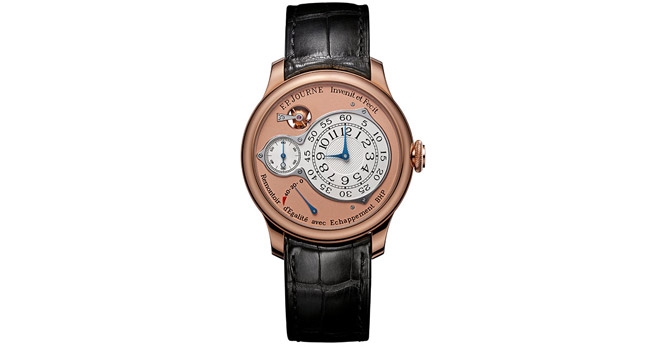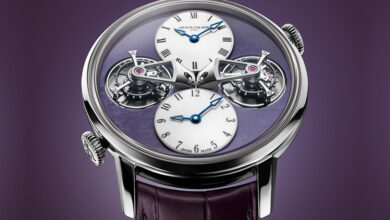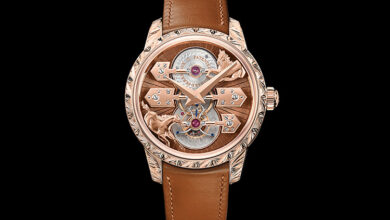Haute creations from F.P.Journe

The Maison of F.P.Journe combines the science of watchmaking with the art of Haute Horlogerie very effectively. Combining a rich knowledge of the history of time with modern technologies, the Chronomètre Optimum is another prestigious addition to the great iconic timepieces of F.P.Journe, as is the Élégante in Powder Rose
Chronomètre Optimum
The Chronomètre Optimum symbolises the very essence of precision for a wristwatch endorsing the accomplishment of F.P.Journe chronometric research. The double barrel with its two springs ensures the stability of the driving force of this emblematic movement made of 18ct rose gold, a speciality of the brand.
The constant-force remontoire (patent EP1528443.A1) balances the driving force applied to the escapement to make it constant. By adding an extra gear representing an independent system wound in short spurts by the mainspring, the escapement ensures the balance’s isochronism. This remontoire, made of titanium for the first time, maintains its balance in different positions, for greater efficiency.

The EBHP High-Performance Bi-axial Escapement has also been patented (patent EP11405210.3). This two-wheel direct impulse escapement functions without oil and is the only direct impulse escapement to start up on its own. Not only does it function without lubricant, it also has far greater output than the majority of escapements – 50 hours without loss of amplitude. Many dual-wheel escapements have been created in the past, the most efficient being the “natural” escapement invented by A-L. Breguet (†1823).
The balance with a spiral with Phillips curve guarantees better equilibrium.
A natural dead beat second on the back of the movement’s bridge.
The aesthetics of the hour, minute, and small second displays, as well as the 70-hour power reserve are in perfect harmony with the visible wheel of the constant-force remontoir on the face of the dial. The back of the 18ct rose gold movement reveals, through the sapphire back, a surprising natural dead beat second defined by a seconds circle screwed onto the movement’s bridges.
The timepiece has an off centre hours and minutes indication, while the small second is at 9h00, the power reserve at 6h00, and the large dead beat second on the back.
The Chronomètre Optimum comes with a 40 or 42 MM platinum or 18ct red gold case, with a white gold or red gold dial, on a leather strap, platinum, or 18ct red gold bracelet.
EBHP – F.P.Journe High-Performance Bi-Axial Escapement
François-Paul Journe designed the Chronomètre Optimum in 2001, the first time that he integrated the dead beat second into his constant-force remontoire. This dead beat second can clearly be seen and is natural due to being linked to the one-second remontoire. In this watch the constant-force remontoire is visible while the second hand on the main dial ticks away at a speed of 3 Hertz, i.e., 6 times per second (frequency of the escapement).
This watch, in 2004, inspired the Tourbillon Souverain with Dead Beat Second. As he was working on the Octa collection and the various models of those automatic watches at the same time, the Chronomètre Optimum was put on the back burner. Other models such as the Sonnerie Souveraine, the Centigraphe and the Répétition Souveraine were prioritised.
The basic premise was to make a watch with less internal friction, a constant force on the escapement to ensure isochronism and an escapement without lubrication to ensure stability.
1) Friction: To reduce friction the two barrels in parallel eliminate the lateral pressure to which the great wheel is subjected and exert a more stable force on the wheel train.
Isochronism: The balance’s oscillation rate must always stay the same. Unfortunately the spiral is always imperfect, making it impossible to achieve this when amplitudes change due to the energy of the spring weakening. The constant-force remontoire (patent EP 1 528 443 A1) achieves constant amplitude for the first 45 hours of power reserve.
2) The escapement (EP11405210.3) patented under the name of EBHP is a direct impulse escapement, which means that the escapement wheels supply impulse directly to the axis of the balance. In the 18th century there were several direct impulse escapements: the spring detent or pivoted detent escapement, the Robin escapement, Breguet’s natural escapement, etc. All these escapements work without oil but are not suitable for wristwatches.
Modern escapements are assumed to be self-starting and to have the stabilising features required to deal with arm movement. For this reason, the EBHP has an original geometry enabling automatic starting and a configuration of ruby pallets blocking the escapement wheels at a specific angle, similar to the Swiss anchor escapement, enabling “recoil”. This isolates the blocking anchor from the balance in order to stabilise it during movement on the wrist.
François-Paul Journe’s watchmaking philosophy is to make watches that will still work in 200 years. Those made 200 years ago are still in working order if they have been maintained regularly. It is for this reason that he only uses solid materials that have proven their worth rather than modern materials that may be difficult to be repaired in a few decades.
Variations in some of the watches from the Souveraine collection:
The Chronomètre à Résonance achieves a constant rate when exposed to movement on the wrist. This watch is very accurate because its rate is not affected when the watch is worn.
The Tourbillon Souverain: The classic tourbillon is not generally a very good watch, but when combined with a constant force remontoire, its stability is guaranteed.
The Chronomètre Souverain has the same accuracy as the Chronomètre à Résonance but does not cancel out the effects of being worn.

Élégante in Powder Rose
The Élégante is François-Paul Journe’s answer to the repeated requests made to him by the wives of his customers to create an Haute Horlogerie watch for them. This year, the Manufacture is bringing out different editions of this elegant timepiece, with the Powder Rose version being the latest in the series.
The development of this innovative electro-mechanical concept took eight years of research. The calibre 1210 is very comfortable to use while offering the performance of an electro-mechanical watch that combines reliability and precision. The Élégante houses the only electro-mechanical movement conceived and created for the luxury market and offering a true vision of luxury.

Understanding that his female clientele may not like to spend time winding watches, François-Paul Journe has ensured that the Élégante goes into standby mode after 30 minutes of motionlessness; the mechanical motion detector visible at 4h30 is at rest. During this standby mode, the microprocessor continues to keep time, while the mechanical parts, gears, rotors and hands stop turning. The energy thus saved provides a very long autonomy from eight to ten years in daily use, and up to 18 years in standby mode.
On detecting motion, the Élégante sets itself automatically to the current time, taking the shortest path – either clockwise or counter-clockwise. All the mechanical parts of its movement are manufactured in the Manufacture’s own workshops in Geneva – based on the brand’s own criteria of excellence in state-of-the-art haute horology – ensuring that the Élégante is a completely in-house production.
Developed by a Swiss engineer and made in Switzerland, the electronic components are crafted to exclusive and exacting standards, with a microprocessor specifically created for the Élégante. The luminescent dial of the Élégante ensures perfect legibility, both in the day and by night.
The Élégante in its new avatar of Powder Rose is housed in a titanium case of 40MM, decorated with 38 VVS diamonds, ceramic powder rose inserts, luminescent dial, and powder rose rubber strap.





